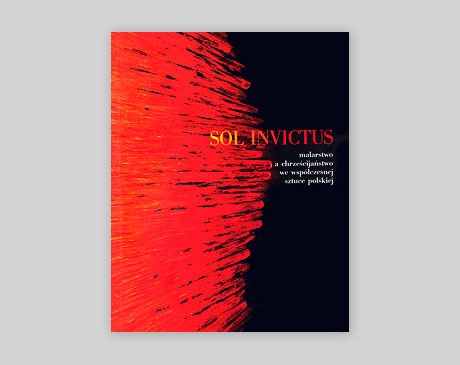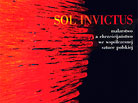Sol Invictus. Painting and christianity in Polish Contemporary Art

Artists:
Stefan Gierowski
Koji Kamoji
Jan Lebenstein
Alfons Mazurkiewicz
Jarosław Modzelewski
Jerzy Nowosielski
Stanisław Rodziński
Wojciech Sadley
Jacek Sempoliński
Jacek Sienicki
Marek Sobczyk
Andrzej Szewczyk
Leon Tarasewicz
Jacek Waltoś
year of publication: 2003
size: 16 × 20 cm
volume: 304 pages
binding: softcover
reproductions in colour
languages: Polish/English
edited by: Stanisław Ruksza
graphic design and typesetting: Krzysztof Morcinek
publisher: BWA Contemporary Art Gallery in Katowice
ISBN 83-88254-23-5
Price: 10 zł (about 2,50 euro)
Visit our bookshop or order by e-mail:
ksiegarnia@bwa.katowice.pl

I wish the reality were back to our speech.
I think about the sense which is impossible
without the absolute point of reference.
Czesław Miłosz, The Theological Treatise
Sol Invictus, the title of the exhibition, which means the Invincible Sun, comes from the Christian iconography of the first millennium. At those times the main topics of Christianity, that is the Resurrection, the Transformation and the Second Coming, have been the source for various pagan imaginations of Helios — the Sun and for ideas derived from the conception of Christ as “the Light of the world” (Jn 1, 1—9; 8,12).(1)
Various iconographical formulations of the Sol Invictus appeared in order to oppose the pagan idolatry. At the same time they have superbly articulated and made people aware of the idea of Christ’s divinity. In effect, they survived the Middle Ages and new times. We are not, however, interested here in the modifications of the iconographical canons or symbolic illustrating which are frequently used in today’s references to the archetype of solarity within the New Age movements, or in common simplicity copies in church realisations.
Sol Invictus is only a joining password. Sol Invictus is synthesising. It reconciles the new with the old, finding the actual form for the essence. It allows for the dialogue. It allows to join what’s contradictory with the true light (Sol verus). Sol Invictus (The Invincible) does not mean the triumphant light, but the existing one.
The leitmotif of the exhibition is the idea of the light of Christian provenience. We want to show the continuity of art that draws from Christianity. Simultaneously we want to ask about the topicality and condition of such kind of art. This question is provoked by the diagnosis made by Chantal Millon-Delsol. She wrote that traditional historic religions (the Catholic Church above all) have lost their power of spiritual inspiration for man, closing themselves within a circle of dogmas and traditions, in “Byzantinism” and formalism.(2)
Chantal Millon-Delsol’s diagnosis refers to the widely understanding of the spiritual condition of our times. How does it look like in art? Is that so that we have only next new and new poor substitutes for Marcel Duchamp strenuously seeking for his auditor? Is it only a voice of criticism, even though necessary, that exposes the “cracks of our cave”? Is it only a selective inspiration with religion as a generalised sacrum in the shape of the neo-conservative post-modernism of the kind of Daniel Bell, where it plays only a functionalist role? There are, however, other voices…
Inseparable relationship between art and religion began to change in the middle of the eighteenth century. We can read about those transformations with André Malraux: “Traditions will cease to order the future. Simultaneously, history will stop function, because human adventure will not ask God about its sense any more [*]. Illusion will be called reality”.(3) The civilisation of the Enlightenment and, wider, the whole post-Cartesian stream of European culture starts the modernity, a symptom of which is taking the place of God. Something new is coming… the reality — realism. Then the post-modernity — discouragement (the objective mind appeared to be a failure). Therefore the reality and realism remain…
Art’s reaching to the world of religion (here the Christianity) and the return toward the spheres considered as the past ones is, in fact, a turn towards the reality of the “absolute point of reference”. This allows the use of the notion of truth (Sol verus). Such art, we can say firstly, uses the tradition, and secondly, tries to see and embody the concealed reality; this puts art into metaphysical categories. Tradition used with mind effort and with giving the tradition a lively shape are the shield against the “promotion” to be an “disinherited artist” and against impostors. However, it is not a closure or an escape from the new, because it causes constant confrontation. The same is with the metaphysical quality and with reaching to what’s “beyond”.
Through its “absolute point of reference”, art that draws from Christianity becomes an alternative art. Inspiration with Christianity as a linear vertical time of the Great End/Start is coming out from the time exclusively present, that is from the dissatisfaction with the limitations of the current moment, taking the distance and therefore saving it.
Sol Invictus of ancient genesis was once assimilated with new values of essence, for which topical possibilities of expression have been searched. Today we need a defined form for the traditional message. The fundamental image of Christianity — Christ on the Cross — has been treated as an exhausted image. Friedhelm Mennekes’s installation was a significant example of this; he replaced the cross at the tower of St. Peter church in Cologne with a neon inscription saying in several languages “don’t worry”. This neon light — “Sol Praesens” – is an action that shows at the need of new, contemporary forms.
Therefore, can traditional religions still be the guide, or the inspirer of art? Are those features of “Byzantinism” and formalism, in which Millon-Delsol sees the unattractiveness of religion, well confirmed? It seems, however, that traditional religions are a constant base and bearing of culture. They can help to open us at the mystery of man. All the more, the phenomenon of faith and the fact of religious inspiration seem to be extra-institutional. Modified by the artistic imagination, it appears “on the edges” of religion.
In art, like in life, “it is not very good to urge today’s man and his religious faith to reject the presumably incomprehensible Byzantinism. That is to reject the language of old symbols, which have included with their religious imagination the oldest human desire: to join in the higher order of sense, to take part in it with our thoughts and feelings, understanding and longing, and to build the spiritual reality with imagination. In it there is a place for the past and the present, for subjectivity and community, for hermeneutic cognition and for the barrier of mystery” (Ewa Bieńkowska). (4)
As one of the exhibitions that try to “rehabilitate” this form of expression, the Sol Invictus exhibition is concentrated on painting. Fourteen artists from several generations are presenting their works being a specific pars pro toto of their creation (5); in alphabetical order they are as follows: Stefan Gierowski, Koji Kamoji, Jan Lebenstein, Alfons Mazurkiewicz, Jarosław Modzelewski, Jerzy Nowosielski, Stanisław Rodziński, Wojciech Sadley, Jacek Sempoliński, Jacek Sienicki, Marek Sobczyk, Andrzej Szewczyk, Leon Tarasewicz, Jacek Waltoś.
Relationships with Christianity are realised in many ways: through the direct connection with a theme, symbolical references or forms that can “sense” the deeper sense of being. The selection does not pretend to be the complete presentation of the problem. The purpose is different. Various attitudes and formations, forms and poetics, allow showing the multivector landscape of Christian sacrum that is different from the stereotypical one which was built on the groundwork of the church art of the eighties.
“Sol Invictus”:
includes the artistic phenomena of the eighties (rich in artistic events, and poor in accomplishments). Works from that period are not treated only in the context of the system of the time, where they were to express nothing more than patriotism. It shows at “winning” works that are not revalued. It breaks with the easy accepted chronology, that is with the year 1989, thus making the present day to be the last point. This can put works that came into being after 1989 in natural development,
does not show the works of young artists who distance themselves from going to a higher reality (are they really… realists?”), or have no worked out language yet (“Young man won’t write such a treatise” — this is how Miłosz commences his Theological Treatise),
presents the artists that are associated with the avant-garde. Thus it shows at the stereotypical treatment of this formation in categories of all progresses and at the need of undertaking new investigations on the Polish art of the twentieth century. This would show the turns of the avant-garde towards spirituality as an antidote to the triumph of scientism and materialism (however, in the face of the “absolute point of reference” do we have the progress or a passing-by?).
Painting and Christianity uncover new spaces. Articles placed at the beginning of this book and preceding the presentations of the artists are introducing us into many problems of this phenomenon.
This introduction invites us to discussion on perspectives and problems of meeting art with religion. No matter how we analysed this Meeting, we should divest ourselves of various prejudices, because it is an accumulation of both areas that are always full of mystery.
Stanisław Ruksza, The Curator
(1) More on solar symbols in Christianity and other definitions of Christ as the Sun see J. Miziołek, Sol verus, Wrocław — Warsaw — Cracow 1991
(2) Ch. Millon-Delsol, God on Exile, “Znak” 557 (10) 2001, p 9-23; the polemic articles see ibidem
(3) A. Malraux, Transformation of Gods. The Timeless, Warsaw 1985, p 7
(4) E. Bieńkowska, What to do with the past of religion?, “Znak” 557 (10) 2001, p 47
(5) The scenario of the exhibition included also the pictures by Waldemar Cwenarski, Crucifixion and Pieta, which find Christ in the reality of war

